#leitao
Photo

Warmbox . Se pronuncia “Uarmbox”, é o forno do Pit, a caixa térmica em tradução livre. Podemos usar a warmbox tanto para defumar as carnes, manter elas aquecidas ou até finalizar a cocção, tudo vai depender da temperatura que utilizarmos. Normalmente utilizamos a warmbox para liberar espaço na câmara de defumação, primeiramente defumamos as proteínas no cilindro, depois embalamos e finalizamos no forno. Qual o uso mais inusitado que você já fez com o forno do seu Pit? Comenta aí! O meu foi para aquecer pizza. . . . #bbq #pig #pork #smokedpork #smokedmeat #paleo #meat #pulledpork #bbqroots #bbqbueno #southcarolina #usa #hog #wholehog #sucklingpig #leitao #defumacao #churrasco #churras #brasil #oversmoke #smoke #warmbox #pit (em Caxias do Sul) https://www.instagram.com/p/CmovdxnLBgI/?igshid=NGJjMDIxMWI=
#bbq#pig#pork#smokedpork#smokedmeat#paleo#meat#pulledpork#bbqroots#bbqbueno#southcarolina#usa#hog#wholehog#sucklingpig#leitao#defumacao#churrasco#churras#brasil#oversmoke#smoke#warmbox#pit
0 notes
Photo
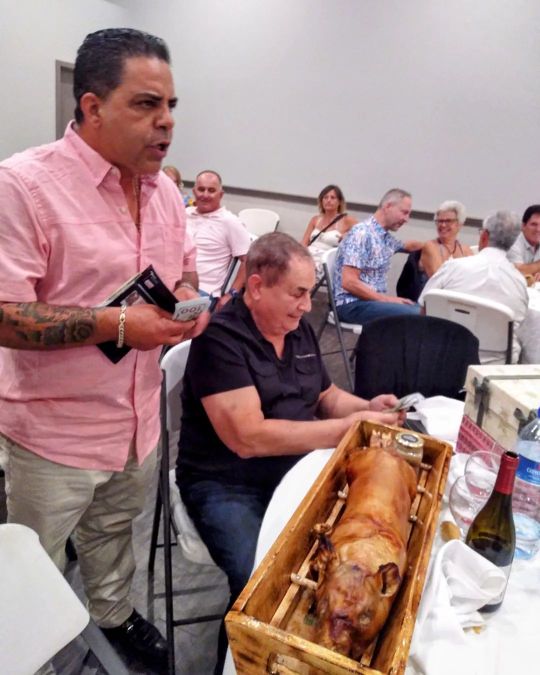
At Carlos & Selena fundraising event. #português #leitao #event #palmcoast #flaglercounty #florida #jackbarbosa #drbarbosanews (at Portuguese American Cultural Center of Palm Coast,Fl) https://www.instagram.com/p/CfQZiKkNA_0/?igshid=NGJjMDIxMWI=
0 notes
Text

From Renata Leitao's Galeria Collection 2023
14 notes
·
View notes
Text
Upcoming Portuguese Wedding

The Duke and Duchess of Braganza have announced the engagement of their daughter, Infanta Maria Francisca, and Duarte de Sousa Araújo Martins. The Duke of Braganza is the current claimant to the Portuguese throne and the family is still invited to many royal events and even attends state banquets in Portugal.
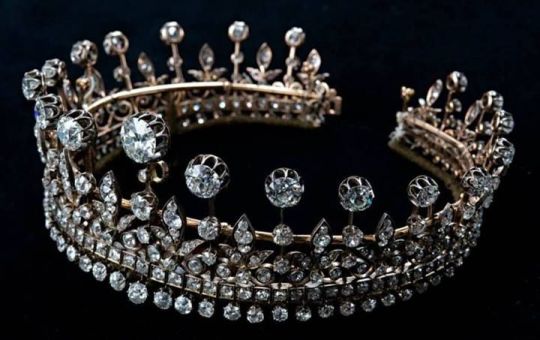
I'm hoping that Infanta Maria Francisca wears Queen Amélie's Diamond Tiara like her mother did on her wedding day. I don't have a post on it yet but here are some from other blogs. It was made in 1886 by Leitão & Irmão and was a wedding gift to Queen Amélie from her father-in-law, King Luís I of Portugal, so you'll sometimes see it called the Dom Luis Diadem.

The royal wedding calendar is really filling up for 2023. I'm not even going to be able to feature them all in my tiaras to look forward to post.
#Tiara Talk#Infanta Maria Francisca#Portugal#Portuguese Royal Family#tiara predictions#tiara#Duchess of Braganza#Leitao and Irmao#diamond#bridal tiara
54 notes
·
View notes
Text

Chaque porte qui se ferme ouvrira une autre - Marianne Leitao
#citation#citation du jour#tumblrpost#illustration#photography#picture#art#tumblr#tumblrphoto#tumblrlife#quote#quotes#quoteoftheday#marianne leitao
1 note
·
View note
Text

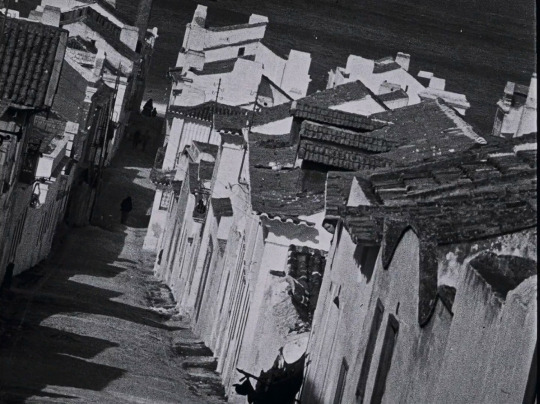




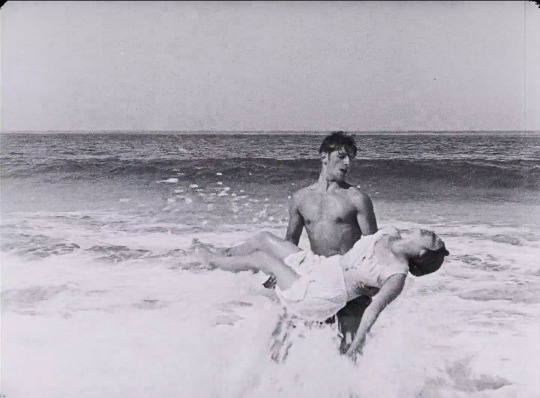


Maria do Mar, José Leitão de Barros, 1930
0 notes
Text
Although Iuri Leitao… what an omnium he did!! Truly the world champion today!
0 notes
Text
Hair offerings: historical context, purpose and uses
Offerings of hair, locks of hair or ritual hair-cutting is quite a regular occurrence in ancient sources and textbooks discussing various religious customs of the ancient Greek world. It also seems to be a fairly forgotten offering in a modern context, which is why I wanted to delve back in and write this post. I will be focusing on laying out the historical contexts in which we find this specific offering in order to understand the core logic behind what it means to offer a lock of hair to a deity.
Rites of passage
It is impossible to mention offerings of hair without touching on the topic of “rites of passage”. However, this is an umbrella term that encompasses different kinds of rites or life events depending on the environment and stage of life of the participants.
Kourotrophic hair-cutting
Arguably the most common example of offerings of hair is the one done by boys, typically when entering adulthood (typically referred to as paides or ephêboi), but there are important variations depending on the era and local customs, with the youngest example known being the one of a 4-year-old boy in the 3rd century BC.
Kourotrophic deities typically refer to Apollo, Artemis and the plentitude of local river gods. However, this is far from being the only gods considered kourotrophoric since we also have evidence that includes Poseidon, the Nymphs, Asklepios and Hygieia in that group.
There were several occasions for which young boys would offer their hair. In Athens, later sources mention that the 3rd day of the Apatouria festival included the ritual cutting and offering to Artemis of the hair of the young men who officially entered their phratries after having made an offering of wine to Herakles.
In a wider context, kourotrophoric deities are concerned with the growth and well-being of children and adolescents. It seems common that offerings were made pursuant to a vow, often done by a parent while the adolescent is still a child (or even just born). Their purpose is to help assure successful maturation, but they seem to work by establishing a positive relationship with the kourotrophic deity. These rites unfold over a long period of time: there is a vow, a period of hair growth that might last for many years, and then, a ceremonial cutting.
Pausanias gives us an example of ritual growing of the hair for the river god Alpheios in his story about Leukippos, stating he “wove the hair he was growing for the river Alpheios in the same way that maidens do.” (Pausanias 8.20.3)
The organization of the final cutting seems to have been a familial event that included the participation of the parents, if they didn’t even make the offering themselves on behalf of the son. Three inscriptions from the island of Paros in the 3rd century AD describe the offering of “childhood” or “ephebic” hair done by a parent to Asklepios and Hygeia, instead of being performed by the boy himself.
A noteworthy example from Thebes shows the participation of a brother instead of the parents (see image below). In this case, the dedication of the hair, shown braided, is made to Poseidon by Philombrotos and Aphthonetos, sons of Deinomachos. David Leitao rules out the possibility of this inscription being about a votive, in favour of it being a rite of passage for two reasons: firstly, the locks that are sculpted in relief on the stele are long and carefully braided, and reminiscent of the braids frequently seen elsewhere on the heads of boys and adolescents in Greek sculpture. Secondly, Poseidon seems to play an important role in the growth of children in Thessaly in particular.
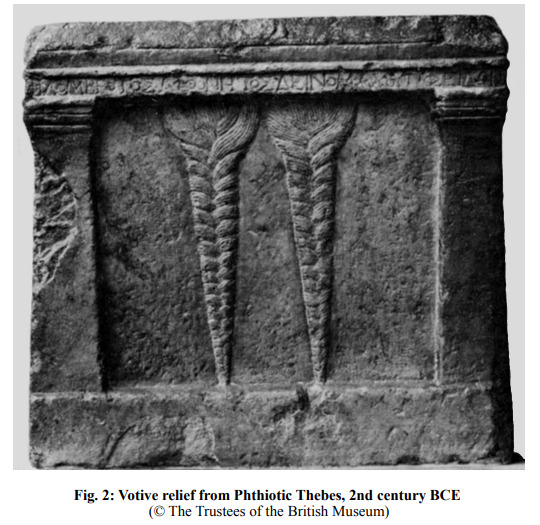
Further reading for this section:
→ Leitao, David D. "Adolescent hair-growing and hair-cutting rituals in ancient Greece: A sociological approach." Initiation in ancient Greek rituals and narratives. Routledge, 2013. 120-140.
→ Pilz, Oliver. "Water, Moisture, Kourotrophic Deities, and Ritual Hair-Cutting among the Greeks." Les études classiques 87.1-3 (2019).
Marriage
If young men grew and offered their hair to kourotrophoric deities at a young age, girls and young women tended to offer a lock of hair a bit later, as part of the pre-nuptial rites. While the practice was widespread throughout the Greek world, we can use this passage from Herodotus (4.34) concerning the citizens of Delos to illustrate the phenomenon:
“And in honor of these Hyperborean girls who died in Delos, the girls and boys of Delos cut their hair. The girls cut off a lock before marriage, wind it around a spindle, and place it on the tomb (the tomb is within the sanctuary of Artemis, on the left side as one enters, and an olive tree grows there); and the Delian boys wind some of their hair around a kind of grass and they, too, place it on the tomb.”
Similar pre-nuptial rites are attested elsewhere: in Troezen, the brides dedicated a lock of hair to the temple of Hippolytus (Pausanias 2.32.1) while in Megara, the brides made the offering on the tomb of the maiden Iphinoe.
Offerings of hair before marriage is only one of the many pre-nuptial offerings. Katia Margariti calls it a “very symbolic premarital offering” and notes that in most of the cases mentioned, the brides offered their hair to maidens who had died before they could transition into adulthood. Hippolytus, son of Theseus, stands as an exception, the aetiological myth behind the rite being that he angered Aphrodite by staying chaste in honour of Artemis, which caused his tragic death (before being resuscitated by Asklepios). It is in this context that he places himself as an appropriate recipient for the offering of brides.
In Athens, the offering of hair from brides was addressed to Artemis directly instead, but it could also be made to Hera and/or to the Nymphs.
Let me quote Evy Johanne Håland to summarize what has been said so far:
“The cutting of hair, ‘the crown of childhood’, admits boys and girls to society, announcing their passage to adulthood and marriage. By offering the aparchai, first fruits or primal offerings, to the life-giving waters, boys who were initiated as warriors and girls ensured their fertility in their married lives. Haircutting symbolizes the transition to another stage in life. This practice is found in ancient and later periods of Greece, where the fountains were decorated with maidenhair until modern times. In this connection the theme of death and rebirth is important, since the initiates are reborn into a new life. Moments of transition from one state of life to another are high points of danger, and the person is especially vulnerable to spirits, agencies, influences, or invisible mischief.”
Further reading for this section:
→ Oakley, John Howard, and Rebecca H. Sinos. The wedding in ancient Athens. University of Wisconsin Press, 1993.
→ Margariti, Katia. "The Greek Wedding outside Athens and Sparta: The Evidence from Ancient Texts." Les Études Classiques 85.4 (2018).
→ Dillon, Matthew PJ. "Post-nuptial sacrifices on Kos (Segre," ED" 178) and ancient Greek marriage rites." Zeitschrift für Papyrologie und Epigraphik (1999): 63-80.
→ Håland, Evy Johanne. "“Take, Skamandros, My Virginity”: Ideas Of Water In Connection With Rites Of Passage In Greece, Modern And Ancient." The Nature and Function of Water, Baths, Bathing and Hygiene from Antiquity through the Renaissance. Brill, 2009. 109-148.
Death, the dead and departures
With everything that has already been brought up, it comes as no surprise to find offerings of hair in funerary context. Death is, after all, a great transition, both for the deceased and the one suffering the loss of a loved one.
The premarital offerings of hair already hinted towards a link to death, whether it is through the remembrance of a dead hero or, more symbolically, the death of childhood.
While not a dedication to a deity, the symbolism of hair in the context of remembrance is something also found in a gesture connected with the memory of fallen soldiers: the warrior cuts strands of his hair, which after his death were then handed over to his relatives.
It is tempting to link this gesture to the funerary rituals that involved hair. As such, already in the Archaic era, it was customary for each attendee of a funeral to place a lock of their own hair upon the remains of the deceased. The Iliad gives us an idea of such a rite in Book 23 and to the rite of growing hair for a river god.
“No, before Zeus, who is the greatest of gods and the highest, there is no right in letting water come near my head, until I have laid Patroklos on the burning pyre, and heaped the mound over him, and cut my hair for him, since there will come no second sorrow like this to my heart again while I am still one of the living.”
“In the midst of them his comrades bore Patroklos and covered him with the locks of their hair which they cut off and threw upon his body. Last came Achilles with his head bowed for sorrow, so noble a comrade was he taking to the house of Hades.”
“He went a space away from the pyre, and cut off the yellow lock which he had let grow for the river Spercheios. He looked all sorrowfully out upon the dark sea, and said, "Spercheios, in vain did my father Peleus vow to you that when I returned home to my loved native land I should cut off this lock and offer you a holy hecatomb; fifty she-goats was I to sacrifice to you there at your springs, where is your grove and your altar fragrant with burnt-offerings. Thus did my father vow, but you have not fulfilled the thinking of his prayer; now, therefore, that I shall see my home no more, I give this lock as a keepsake to the hero Patroklos. […]As he spoke he placed the lock in the hands of his dear comrade, and all who stood by were filled with yearning and lamentation.”
The implications of this passage would deserve its own post, and I won’t dwell on this, but we can clearly see the double layer of symbolism at play with the locks of hair alone.
When it comes to burial rites, beyond the Archaic customs, Ochs interprets the custom this way: “Rhetorically, cutting a lock of hair and placing it in the grave can be understood as a message of collective solidarity. All mourners in the polis engaged in the same action and, thus, by doing so reaffirmed the cohesion of their beliefs. Note also that the collective, dedicatory message is directed at the deceased. The symbolic behavior, therefore, visually links the living community with the dead person or, more accurately, the dead person's spirit. In other words, the message is one of aggregating the living with each other and the living with the soul of the deceased.”
We can also find another purpose in the scope of ancient tragedies about Orestes and Elektra, where post-burial offerings are used to pacify the dead and to convey personal affection primarily through the use of food and drink. The lock of hair is also found but it functions in the plays as a device for recognition.
Further reading for this section:
→ Closterman, Wendy E., A. Avramidou, and D. Demetriou. "Women as gift givers and gift producers in ancient Athenian funerary ritual." Approaching the Ancient Artifact: Representation, Narrative, and Function. A Festschrift in Honor of H. Alan Shapiro (2014): 161-174.
→ Barbanera, Marcello. "Dressing to Hunt: Some Remarks on the Calyx Krater from the So-Called House of C. Julius Polybius in Pompeii." Approaching the Ancient Artifact: Representation, Narrative and Function. A Festschrift in Honor of H. Alan Shapiro (2014): 91-104.
→ Ochs, Donovan J. Consolatory rhetoric: Grief, symbol, and ritual in the Greco-Roman era. Univ of South Carolina Press, 1993.
Votives
Last but not least, now that the heavier ritual uses have been covered, is the topic of hair offerings as a way to say “thank you”. Similarly to how the offering of hair from young boys to river gods came as a petition for safety, we find locks of hair being used as thanks to surviving dangerous situations like illnesses or an escape from a disaster.
A Hellenistic epigram names the rescue from distress at sea as reason for a ritual hair-cutting, where a man named Lukillios shaves off his hair for Glaukos, the Nereids, Melikertes, Poseidon and the Samothracian gods as thanks for surviving the incident.
Another example is one told to us by Pausanias concerning the cult of Asklepios and Hygieia in the city of Titane:
“Of the image [of Asclepius] can be seen only the face, hands, and feet, for it has about it a tunic of white wool and a cloak. There is a similar image of Hygieia; this, too, one cannot see easily because it is so surrounded with the locks of women, who cut them off and offer them to the goddess, and with strips of Babylonian raiment. With whichever of these a votary here is willing to propitiate heaven, the same instructions have been given to him, to worship this image which they are pleased to call Health.” (Pausanias, Description of Greece 2.11.6–7)
While it is impossible to know the exact reasons why each of the women offered their hair to Hygieia, the idea that it was in return for health sounds the most logical.
In the sanctuary of Zeus at Panamara in Caria hair was either enclosed in a small stone coffer in the form of a stele and set up in the precinct with an inscription placed upon it, or placed in a hole in the wall or hung upon the wall with a small label placed upon it. The former was probably for the wealthiest citizens, while the latter reserved for those with less means. In the case of the former, the hair itself was no longer visible, but the stele and inscription were. In the case of the latter the hair remained visible in conjunction with a label that named the dedicant. The care put into storing the locks in these examples is telling of an offering that is symbolically charged and likely lasted a lifetime, due to the durability of hair.
Similarly, an epigram in the Palatine Anthology, attributed to Antipater of Thessalonica poetically tells of the hair offering of a young man to Apollo:
“Having shaved the down that flowered in its season under his temples, [he dedicated] his cheeks’ messengers of manhood, a first offering, and prayed that he might so shave gray hairs from his whitened temples. Grant him these, and even as you made him earlier, so make him hereafter, with the snows of old age upon him.”
While this epigram is clearly related to the idea of hair-cutting for young boys, as it refers to the growth of the first facial hair, it also begs the question of the quality of the appearance of the first white hair. Aside from being a poetic call to the blessing of living a long life — long enough to know old age — we might want to wonder about what it would mean to offer one’s white hair within the logic of transition from adulthood to seniority.
Further reading for this section:
→ Draycott, Jane. "Hair today, gone tomorrow: The use of real, false and artificial hair as votive offerings." Bodies of Evidence. Routledge, 2017. 77-94.
Final thoughts
If there is something to take away from the historical uses of hair in the religious setting of the Ancient Greeks, it is the idea of transition. From the entrance into adulthood to death, hair offerings come up at key moments in one's life, or at least, in answer to brushes with death, placing hair in a very important position. It is a highly personal, intimate and symbolic offering.
While this post isn't the place to discuss modern reinterpretations, I think the key to integrating hair offerings in reconstructionist practice comes down to asking yourself the question of what the milestones in our modern lives are and what they mean, alongside other life-changing events.
#hellenic pagan#hellenic worship#hellenic revivalism#hellenic reconstructionism#hellenismos#hellenic paganism#hellenic polytheism#hellenic gods#offerings
557 notes
·
View notes
Note
Hi there! I've really enjoyed your blog-- there's a lot of good information on it. In fact, I just wrote a novel set in ancient Thebes, set in 335 BCE, right before Alexander's attack. However, I'm a little scared to write the sequel, because Alex is going to show up in it as a major character. He is SO famous, and there's so many books about him, that I hardly know where to begin.
So, do you have any specific books you recommend, like any good starter bios or anything else that would be good for this specific setting? (Specifically against the destruction of Thebes and right before the invasion of Persia.)
Thank you so much!
Some Useful Bibliography on Alexander (and Thebes)
Thank you! And sorry for the delay. The queries in my inbox tend to be feast or famine. LOL
In terms of information on Alexander, I would start with the brand new Cambridge Companion to Alexander the Great, edited by Daniel Ogden. It has many of the leading scholars. On Alexander and the Greeks in particular, see my dear friend Borja Antela’s chapter. This is now what I’d consider the best intro resource on Alexander for the interested non-specialist, especially as it’s reasonably priced. The bibliography will help a lot. For Macedonia itself, Carol Thomas has Alexander and His World (which I’ve used teaching) and Carol King has Ancient Macedonia. Both are good, one-book introductions.
If you’ve not already, you’ll want to consult Mark Munn’s chapter “Thebes and Central Greece” in The Greek World in the Fourth Century, Larry Tritle, ed. Paul Cartledge also has a book Thebes: The Forgotten City of Ancient Greece, but he’s a Spartan specialist. Lately, publishers have had him write on other subjects—not always to good effect, as per his book on Alexander, imo. But I’ve not read this one so can’t comment. I think Thebes is closer to his usual bailiwick.
James Romm did a book The Sacred Band., although like Cartledge Romm is all over the place. Same cautions apply. And I’ll also offer the counter-proposal that the band was not pairs of lovers, by David Leitao, "The Legend of the Sacred Band," in The Sleep of Reason by Martha Nussbaum and Juha Sihvola, eds. His view is not a homophobic diss; it’s a source problem. Plutarch is our sole source for the lovers bit, and he’s notoriously unreliable on some facts, especially when he has an ulterior message.
The more I study Plutarch, the less I trust him. LOL
Last, another friend and colleague, Jenn Finn has written a bang-up chapter on the destructions of both Thebes and Persepolis, for the upcoming collection I edited, so I got a preview. “Urbicide, Memory Sanctions, and the Perso-Macedonian Dynasty.” I’m not sure when the collection will be out, but certainly not before late 2024, and more likely 2025. She might be willing to share the draft, however, if you need it immediately. She’s at Loyola U. in Chicago. As always, Jenn does fantastic work.
#asks#alexander the great#alexander the great bibliography#ancient Thebes#Greek Thebes#The Sacred Band#books on Alexander the Great#ancient macedonia#ancient greece#Classics#tagamemnon
18 notes
·
View notes
Photo
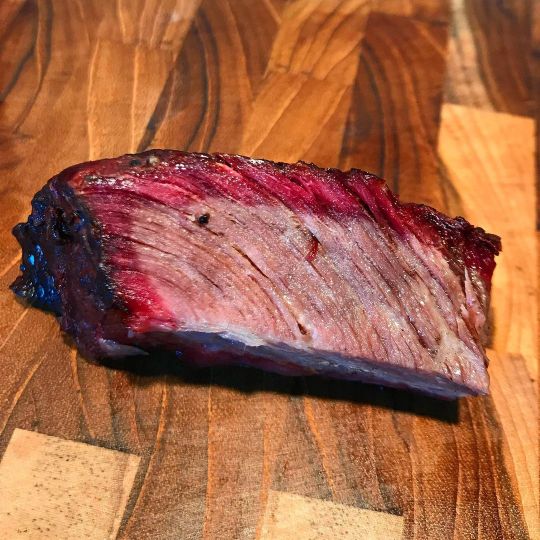
Smoke Ring. Smoke ring ou anel de defumação é aquele anel que aparece na carne defumada, que dá a impressão que ela esta mal passada por fora e bem passada por dentro. A formação do smoke ring acontece quando o oxido nitroso presente na fumaça entra em contato com a mioglobina da carne, isso faz com que a oxidação do ferro presente na mioglobina não ocorra, mantendo a coloração avermelhada e não cinza ou marrom. Nas competições o anel de defumação não é avaliado, pois ele pode ser feito artificialmente com sal de cura. Nem sempre ele é regular e tem a mesma espessura em toda peça, vários fatores podem fazer com que ele tenha variação de tamanho e intensidade. Quantas vezes você já teve que explicar por que a carne estava mal passada por fora e bem passada por dentro? Conta aí! . . #bbq #pig #pork #smokedpork #smokedmeat #paleo #meat #pulledpork #bbqroots #bbqbueno #southcarolina #usa #hog #wholehog #sucklingpig #leitao #defumacao #churrasco #churras #brasil #oversmoke #smoke #smokering #ring (em Caxias do Sul) https://www.instagram.com/p/CmJ0K9YLDNX/?igshid=NGJjMDIxMWI=
#bbq#pig#pork#smokedpork#smokedmeat#paleo#meat#pulledpork#bbqroots#bbqbueno#southcarolina#usa#hog#wholehog#sucklingpig#leitao#defumacao#churrasco#churras#brasil#oversmoke#smoke#smokering#ring
0 notes
Text
"Dionysus’s mixed birth was probably felt, already in the second half of the sixth century, to be a paradox that required some kind of resolution. There appear to have been two major approaches to resolving this problem. One was to upgrade Dionysus’s mother to divine status. We encounter a deified Semele first, in surviving literary sources, in a passage from Hesiod’s Theogony (940–42), a passage almost certainly added during the second half of the sixth century,39 where Semele’s divinity is stated outright. And, in art, there is the altar-pedestal of the cult statue of Apollo at Amyclae, which dates from the middle of the sixth century, which, according to Pausanias, depicted Semele and Dionysus in the company of other gods, almost certainly on Olympus (3.19.3).40
But there was another way to secure a divine mother for Dionysus: give the role of mother to a true goddess in place of the mortal Semele. A new Orphic myth, well established by the early fifth century, made Dionysus the son of Persephone and Zeus, a clear alternative to the traditional genealogy that made Dionysus the son of Semele and Zeus, but one that could and sometimes did accommodate the more traditional one.41 The appearance of new genealogies that solved the theological problem of the god’s maternity may have been fortuitous, but it is also possible that they were contrived for precisely this purpose.42
A second solution was for Dionysus to be born a second time from the body of his father, a myth attested for the first time in surviving sources, as we have seen, in the second quarter of the fifth century. This ought to be an alternative solution to the divinization of Semele or identification of Persephone or some other goddess as his mother. If so, we would expect not to encounter a divine or divinized mother and the birth from Zeus’s thigh in the same account of Dionysus’s birth. And that is precisely what we find in the sixth and fifth centuries. Texts from this period that mention the divinity of Semele lack the thigh birth: the late passage from Hesiod’s Theogony we have mentioned already and two allusions to Semele’s immortality in the first half of the fifth century by the Boeotian poet Pindar (Ol. 2.26; Pyth. 11.1). The converse is also true: the three literary texts from this period that clearly mention the thigh birth – the passages from Stesimbrotus, Herodotus, and Euripides listed at the beginning of this chapter – either explicitly insist on Semele’s mortality (Herodotus, Euripides) or are silent (Stesimbrotus). The first Homeric hymn (to Dionysus), which probably also alludes to the thigh birth and may well date from this period, probably did not, in its original form, mention the divinity of Semele or indeed mention her at all.43 The apparent mutual exclusivity of these two myths – Semele’s deification and Dionysus’s birth from the thigh of Zeus – does not necessarily explain the sudden popularity of myths about Dionysus’s birth beginning in the late sixth century, but it does provide one plausible context, namely attempts to rationalize the Greek pantheon by defining the requirements (e.g., mother and father who are both gods) for godhead."
- The Pregnant Male as Myth and Metaphor in Classical Greek Literature by David Leitao
34 notes
·
View notes
Text
tava mais gorda q o leitao do natal

#borboletana#pro a4a#no food#tw ana diary#disordered eating thoughts#ana mia brasil#anabrasil#garotas bonitas não comem#transtornoalimentar#ana brasil
16 notes
·
View notes
Photo

https://leibal.com/interiors/capitao-leitao/?utm_source=pinterest&utm_medium=social
38 notes
·
View notes
Text
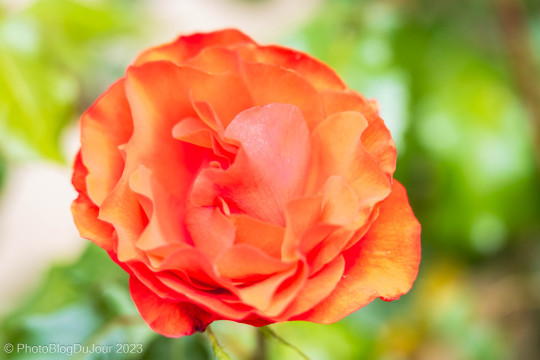
It's Terry again, waitperson at the PBDJ cafeteria and dinner salon. Writers still on strike. This is an orange flower. Tonight, we have veal cutlets, lamb chops, frango (young chicken), and leitao (young pig). I guess at the PBDJ farm they don't let anything get too old before they kill it for food. Me, I'm having the salad, thanks. For dessert there are all sorts of juiced sweet things. Everyone tells me they like our juiced desserts.
#orange rose#macro photography#flowers on tumblr#original photographers#photographers on tumblr#flowers of tumblr#inner life of flowers#macro flower#flower
13 notes
·
View notes
Photo


Amazing Brooklyn, New York City renovated brownstone of designer Delia Kenza and her family is full of original plasterwork, colorful painting schemes, and a collection of African art. The home was passed down to her thru the family.
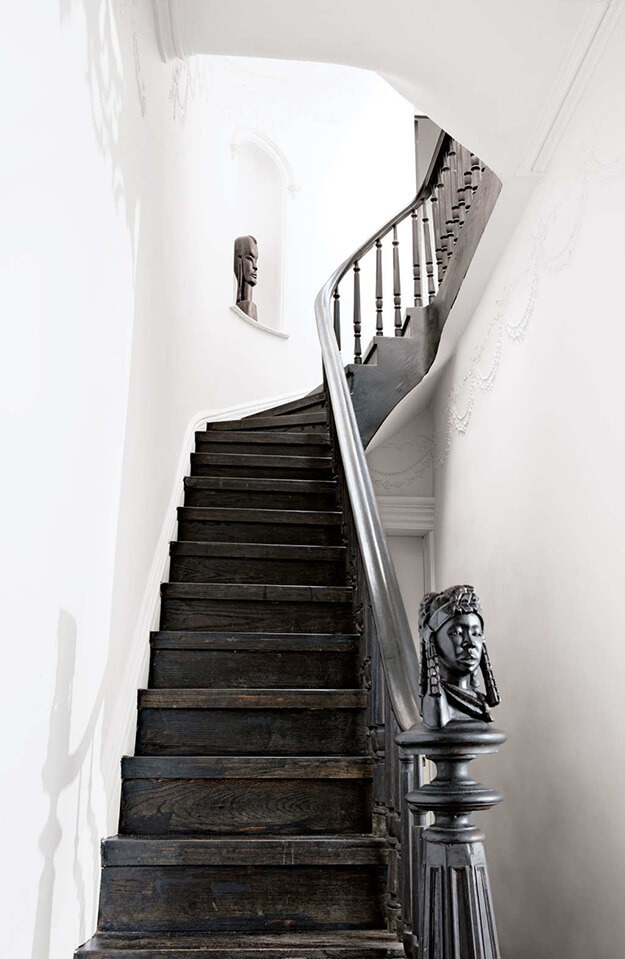
The stairs were rebuilt in place. The carved wood bust on the newel post is from the Mwila people of Angola.


The mirror over the fireplace is from Restoration Hardware. The wall sculpture is an art piece, and the plexiglass table is vintage.

Original 1900 plasterwork in the doorway. The chairs are called “drop chairs,” b/c of their shape.


Although it doesn’t look like it, the light fixture is vintage. The kitchen also features a beautiful marble fireplace.

This original artwork on the landing is a portrait of the family.


In the main bedroom are LED floor lamps, a faux fur blanket and a photograph of dancers in her husband Julio Leitao’s dance company.

The main bathroom.

The girls’ shared bedroom.

Framed mirrors in the daughters’ bath gives it a pop of color.

Husband Juilio’s art studio on the top floor.


Gradient-painted stairs — a project Kenza did with her daughter — lead to the basement playroom.

The home has a private deck out back that is accessed from the kitchen.
https://www.curbed.com/2020/10/a-brooklyn-house-passed-down-in-a-stylish-family.html
96 notes
·
View notes
